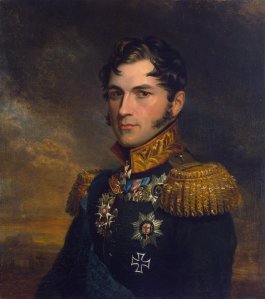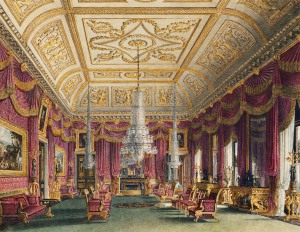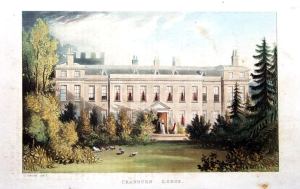 When you read romance novels, it’s easy to fall into one of two camps: You believe stuff like this actually happens or you believe it’s all a fun fantasy, but largely unrealistic. For those in the second camp, allow me to share a true-life story of drama and devotion from the heart of the English Regency. You may have heard it before, but it bears revisiting.
When you read romance novels, it’s easy to fall into one of two camps: You believe stuff like this actually happens or you believe it’s all a fun fantasy, but largely unrealistic. For those in the second camp, allow me to share a true-life story of drama and devotion from the heart of the English Regency. You may have heard it before, but it bears revisiting.
Regency lovers know all about Prinny—the Prince Regent, later King George IV—a royal jerk of the finest vintage. But how much do you know about his daughter? Princess Charlotte was the only child born to him and his not-so-beloved wife, Caroline of Brunswick, on January 7, 1796. Charlotte’s parents were at odds (separated) for her entire life, so she grew up as the bone between two dogs. Naturally, this led to her being something of a wild child, displaying an impetuous and rebellious spirit in ways small and large, from clandestine meetings with inappropriate suitors to letting her underwear show (okay, so it was ankle-length pantalettes that showed a little at the hem, but at the time, some thought it indecent). She even ran away from her father at one point, though she didn’t get very far. When you’re a princess, you’re pretty conspicuous. Besides, she had to ask for help hailing a hack. That’ll slow you down every time.
In 1813, Prinny started thinking about marrying her off, and his preferred match, the Prince of Orange, was decidedly not to her liking. Maybe she was allergic to oranges. In any case, after a lot of pressure and back-and-forth negotiations, she agreed to the match, but her eye had a tendency to wander. First, it landed on a minor Prussian prince named Frederick, for whom she developed quite a thing. Then, she met a fine-looking specimen at a party in London, a Lieutenant-General in the Russian cavalry, the Belgian Prince Leopold of Saxe-Coburg-Saalfeld. She invited Leopold to call on her, which he did, staying for a FULL 45 minutes. Imagine! Later, he wrote a letter to Prinny, apologizing for any indiscretion. George was impressed by Leopold (such fine manners!) but thought the guy was too poor to consider as a possible suitor. Besides, they had Orangey on the hook, so why keep looking?
Naturally, anything George wanted, Charlotte’s mother opposed, including the match with the Prince of Orange. Knowing that Orangey wouldn’t like it, Charlotte demanded that her mother be allowed to visit them after they married. He refused the condition, and Charlotte used the excuse to break the engagement. Now, the fat was really in the fire.
Charlotte had all the public support in England; but she was at the mercy of her father, who was less than pleased. He isolated her at a towered property known as Cranbourne Lodge. Literally, she was a princess imprisoned in a tower. Geez, you can’t make this stuff up. Anyway, she actually enjoyed her time at the lodge more than you’d expect, though not the restrictions. Over time, Prinny loosened up, allowing her to travel to the seaside town of Weymouth. With her allergy to Orange taken care of, and now being able to enjoy a bit of movement about the country, she started feeling better about their daddy-daughter relationship, and by the beginning of 1815 or so, she had made peace with George the Jerk.
Meanwhile, she received news her Prussian crush had become engaged to someone else, so she moved on to her second choice, the handsome Leopold. She wrote to “the Leo,” as she called him, and he was receptive to the idea of marrying her, but he was all tied up with his regiment fighting Napoleon and couldn’t make time for a visit (gee, his enthusiasm was overwhelming). Additionally, she couldn’t get her father to agree that Leo was “the one.” George was still stuck on Orange.

Prince Leopold of Saxe-Coburg-Saalfeld. Honestly, how could Charlotte resist? (Image via Wikimedia Commons).
In the end, she won the battle. The Prince Regent finally accepted her refusal of the “detested Dutchman” (Orangey), and after a great deal of pleading and persuasion from Charlotte, summoned Leopold to Brighton, where Prinny and Charlotte were staying at the time. They all had dinner together, after which Charlotte was more certain than ever that she had made the right choice. She wrote, “I find him [Leo] charming, and go to bed happier than I have ever done yet in my life … I am certainly a very fortunate creature, & have to bless God. A Princess never, I believe, set out in life (or married) with such prospects of happiness, real domestic ones like other people.” George liked Leo, too—well enough that he didn’t want a repeat of the Orange debacle. So, he allowed them to spend time together at carefully arranged dinners, but not much beyond that.
At last, on May 2, 1816, Charlotte and Leo were married in spectacular fashion: The setting was the Crimson Drawing Room at Carlton House; Leo was dressed in the uniform of a British General; and Charlotte wore a stunning gown of silver lamé and net that cost around £10,000. Crowds cluttered London streets for the event, which was wildly celebrated, thanks to Charlotte’s popularity among the citizenry.

The Crimson Drawing Room at Carlton House, where Charlotte and Leo were married. (Image via Wikimedia Commons).
For his part, Leopold was a remarkably sensible and honorable guy. He grew up in Belgium, the youngest son of Francis, Duke of Saxe-Coburg-Saalfeld, and Countess Augusta Reuss-Ebersdorf. When Napoleon moved in and occupied his homeland, he went to Paris, where he polished his diplomatic skills. Napoleon offered him the position of adjutant. He declined. Instead, he moved up in the ranks of the Russian military and fought against Napoleon’s forces at every opportunity, distinguishing himself at the Battle of Kulm. So, you can understand why Charlotte might have gone a little ga-ga over the guy—brave, smart, ambitious, good-looking. Sure, as royalty went, he was impoverished. She even giggled during the marriage ceremony when they got to the part about endowing her with all his worldly goods. But a spoiled fiddle-faddle he was not.
After they were married, they had a few things to smooth out, primarily because of differences in personality. She was still wild and willful, whereas he was a polished, level-headed sort. However, it probably helped that she considered him “the perfection of a lover.” It’s evident that Leo had a calming influence on the princess, and that their affection for one another was genuine. When Charlotte started acting up, all Leo would have to say was “Doucement, chérie,” which translates to “Gently, my love.” He said it so much that she took to calling him “Doucement.” Within the first six months of marriage, those around them noticed the change in her—she was calmer, happier, even dressing more elegantly. Later, Leopold wrote of their marriage, “Except when I went out to shoot, we were together always, and we could be together, we did not tire.”
Unfortunately, it was not all wine and roses. She suffered a couple of miscarriages early on. Later, she became pregnant again, and this time, it looked like she would carry to term. The whole of England celebrated the news, even placing bets on whether it would be a boy or a girl. The royals hired the finest male midwives of the time—today, we would call them “butchers,” but why quibble? They basically starved her, bled her, and misled her with their hackery, failing to perform the most basic medical necessities (e.g., using forceps to assist the birth of a very large baby). Result? The ultimate tragedy: In November 1817, after two days of labor, the princess finally delivered a stillborn son. Her husband reportedly never left her side. Exhausted, both she and Leo slept. But she was weak and bleeding internally. The “physician” tending her realized something was wrong, performed more feckless treatment (hot compresses for bleeding; capital idea), and she soon died from shock and blood loss. (Side note: Recriminations over her death later spurred changes in obstetric practices, which eventually improved childbirth conditions for women. Thank God.)
The entire country mourned their once-future queen. Not until the death of Princess Diana in 1997 did England grieve one of its royals in such a universal way. But Leo suffered the most. He lost both his wife and child within a day of each other. He spent the rest of his life missing her. Yes, he later married again, carried on with his life, became the King of Belgium. But he never forgot his beloved. He even named one of his daughters “Charlotte” in her honor.
Would their marriage have remained happy had she survived? Would she have grown weary of hearing “doucement”? Would he have lost patience with her tantrums? It’s anyone’s guess; after people die, we tend to idealize them, forgetting about all the things that drove us nuts while they were alive. But consider this: Another great love story of the 19th century involved relatives of Charlotte and Leo—Queen Victoria and Prince Albert of Saxe-Coburg and Gotha, whose marriage produced nine children and was much admired for its long devotion. Leo had a hand in making that match, incidentally. And Victoria might never have been born if not for the succession crisis that occurred after Charlotte’s death. But that’s another tale all its own.
Why do I tell this story? Because sometimes we forget that real life can out-romance even romance novels. The human heart is mysterious, love itself is wondrous, and stories of unexpected connection live and breathe all around us. I guess that’s why I’m a romance writer—I believe in true love AND happy endings. Matter of fact, I like to think of Charlotte and her Leo making it work over the long haul, the same way Victoria and Albert did. But, then if that had happened, we might never have heard of Victoria and Albert. Ain’t fate a funny thing? —Elisa


